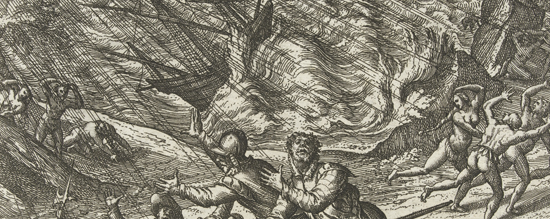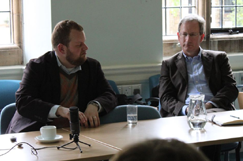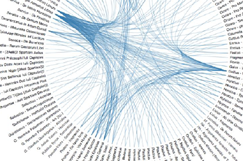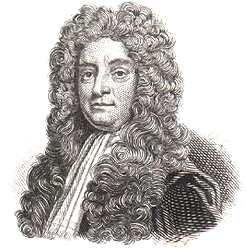* You are viewing the archive for June, 2012

Here in the British Isles, summer is living up to its reputation: that is to say, we’re armed with umbrellas, and battling wind, rain, and flood on a daily basis. Indeed, a seasonal dip into EMLO reveals that heavy rainfall from May to September was not such an unusual occurrence.
Seventeenth- and eighteenth-century summers saw floods the length of the Cherwell valley. There were thunderstorms, whirlwinds and panic-stricken haymakers, damaged crops, stormy summer nights, as well as danger and disruption to transport. There were stiff August winds in the Solent and delays with naval manoeuvres on account of storms in the Channel. The summer of 1682 seems to have been especially wet. Magistrate Edmund Warcup laments the effects of rain on his corn and grass, of floods on his fields and livestock – the poor chap lives in fear of cattle rot – and is forced to take action against the deluge. On 9 May of this same year, clergyman William Jenkyn wrote to Philip Wharton to warn him that ‘the floods are out so bad between Uxbridge & London that it is very dangerous to travel so advises his Lordship to postpone his journey’.
Thus, although all was not gloom and doom during these seasonal soaks (James Long informs John Aubrey that lamprey eels are ‘plentiful in flood time’), it’s small wonder that the time-honoured cliché of sodden summers came into being. As we forego sandals and shorts for galoshes and gumboots, it’s worth reflecting that our ancestors may have been thankful for cold, wet summers as, with the heat in cities, came plague (more on that in a future post), and fine weather was not a cure for all ills. On 6 June 1677 Robert Digby wrote to Thomas Smith that he hoped to see him at the next sitting of Parliament ‘if I can get rid of my cough which wears away, God be thanked, very much this kind weather’, yet favourable temperatures did not work magic in this case; the poor young man was dead by the end of the year.
Miranda is editing metadata from the Bodleian card catalogue of correspondence for our union catalogue, Early Modern Letters Online. On a regular basis, she brings us hand-picked and contextualised records.
James Brown
June 12, 2012
Events, Lectures, Podcasts, Project Updates, Websites and Databases
Tags: Digitization, Editions, Electronic Enlightenment, France, Mapping the Republic of Letters, Networks, Text Mining, Visualization
 Podcast available on the seminar page!
Podcast available on the seminar page!
In the fourth paper of our seminar series on Thursday 17 May, Dr Glenn Roe – formerly of the University of Chicago, and current Mellon Fellow in Digital Humanities at Oxford’s OERC – gave a sophisticated and suggestive paper on ‘Text-Mining Electronic Enlightenment: Influence and Intertextuality in the Eighteenth-Century Republic of Letters’.
.
Building on his recent work with the Electronic Enlightenment corpus and other online repositories of long-form historical text, Glenn started his talk by observing the irony that the recent efflorescence of big data, culturomics, network analysis, and other quantitative approaches to culture – focusing in many cases on the macro interpretation of metadata over content – has authorized and promoted a convention of ‘not reading’ within the digital humanities, in which historical texts themselves can be marginalized or effaced altogether by the superabundance of information. The ready modelling of letters as a finite number of abstract datapoints (sender, recipient, and so on) and the vast quantities of diverse and often disorganized information exchanged within epistolary systems makes correspondence highly susceptible to such an approach.

Glenn during discussion.

Visualizing influence.
As a supplement to this ‘distant’ reading, Glenn went on to demonstrate the potential of the latest machine-learning technologies to render significant volumes of transcription meaningful via text mining and the automated creation of patterns, frequencies, statistical models, and other forms of ‘mediated’ or ‘directed’ reading. Glenn distinguished between three kinds of text mining: predictive classification (used to generate new categories from unprocessed texts); comparative classification (used to correct and refine existing categories within processed texts); and similarity (used to measure broader similarities between documents and parts of documents, especially in terms of the identification of meaningful borrowing and instances of intertextuality). He then demonstrated each kind of approach within a rich series of examples drawn from his work with the ARTFL Encyclopédie Project, and most recently Electronic Enlightenment, before concluding his analysis by presenting – with caveats – some preliminary radial visualizations of textual influence generated using the D3 JavaScript library.
Applications are invited for TWO AHRC Collaborative PhD studentships, commencing in autumn 2012, on the theme of Reconnecting Sloane: Texts, Images, Objects:
- Collecting and Correspondence: Sloane’s Papers and Scientific Networks (Supervised by Dr Arnold Hunt, British Library and Dr Anne Goldgar, King’s College London)
- Putting Nature in a Box: Sloane’s Vegetable Substances (Supervised by Dr Charlie Jarvis, Natural History Museum, and Professor Miles Ogborn, Queen Mary University of London)
- A third Doctoral studentship in the programme, Visualizing Natural Knowledge: Sloane’s Albums of Natural History Drawings (Supervised by Dr Kim Sloan, British Museum, and Dr Elizabeth Eger, King’s College London) has already been allocated to a named student.
Further particulars are available here (doc). Applicants can apply for both studentships, but must complete separate applications for each as outlined below.
 These studentships will focus on the collections of Sir Hans Sloane (1660-1753), which are now divided between the British Museum, the Natural History Museum and the British Library. The research projects will explore various aspects of Sloane’s collections in order to understand how his collecting practices were involved in the making of Enlightenment knowledge. The successful applicants will be expected to work closely with the partner institutions, and each other, in order to draw out the intellectual and material connections between the different parts of Sloane’s collections. They will also participate in the development of new finding-aids for the collections, leading to innovative forms of public engagement.
These studentships will focus on the collections of Sir Hans Sloane (1660-1753), which are now divided between the British Museum, the Natural History Museum and the British Library. The research projects will explore various aspects of Sloane’s collections in order to understand how his collecting practices were involved in the making of Enlightenment knowledge. The successful applicants will be expected to work closely with the partner institutions, and each other, in order to draw out the intellectual and material connections between the different parts of Sloane’s collections. They will also participate in the development of new finding-aids for the collections, leading to innovative forms of public engagement.
The award pays fees and an annual maintenance grant (currently £15,590 per year) and the partner institution will contribute up to £1000 pa research costs. The usual AHRC eligibility rules (pdf) apply to these studentships, including having an appropriate master’s degree by October 2012 and AHRC’s residential requirements.
For both studentships the closing date is 29 June 2012. Interviews will be held in London on 19 July 2012. Applicants will need to include a CV, two references, an academic transcript, and a 1000-word statement of purpose.
 With its whirl of bunting, teapots, cotton frocks, and the river pageant, Diamond Jubilee fever is sweeping the country for just the second time in British history. Early modern subjects might not have had the opportunity to celebrate a sixty-year reign, but it’s clear from Early Modern Letters Online – itself replete with royalty from across Europe – that they knew how to mark in style royal and aristocratic betrothals, marriages, and birthdays, whilst countrywide celebrations of military victories and triumphant peace treaties helped bolster national unity.
With its whirl of bunting, teapots, cotton frocks, and the river pageant, Diamond Jubilee fever is sweeping the country for just the second time in British history. Early modern subjects might not have had the opportunity to celebrate a sixty-year reign, but it’s clear from Early Modern Letters Online – itself replete with royalty from across Europe – that they knew how to mark in style royal and aristocratic betrothals, marriages, and birthdays, whilst countrywide celebrations of military victories and triumphant peace treaties helped bolster national unity.
Then, as now, cities, towns, and institutions arranged peals of bells, official gun salutes, and lavishly styled river pageants for their inhabitants to enjoy. Eminent speakers delivered orations and sermons from pulpits at moments of national importance – we read how ‘Dr. Sherlock is to preach in St. Pauls before Q.Anne to celebrate the glorys and triumphs of the late victorys in Germany. “You may easily imagine that the D. of M. will have no inconsiderable part in the panegyrie”’. Professional intelligencer John Pory wrote to Sir Robert Cotton in 1607 describing the masque Hymenaei which was designed by Inigo Jones and written by Ben Jonson to celebrate the marriage of Robert Devereux, Earl of Essex, and Lady Francis Howard (not that of Prince Henry, as erroneously noted in the abstract). Just as we do today, they enjoyed firework spectaculars; and at the end of the War of the Spanish Succession we find ‘an invitation to the freeholders of Canterbury to partake of a roast ox, bread and beer to celebrate Peace on July 8’ (a service in St Paul’s Cathedral was held also to mark the Peace of Utrecht, at which Handel’s Utrecht Te Deum and Jubilate was given its premiere). As one might expect, bonfires and beacons lit the night sky on numerous occasions and finery was donned for balls and dances, but, in a week during which the highlight here at Cultures of Knowledge has been a paper on the correspondence of James I’s daughter Elizabeth Stuart (podcast to come!), the ‘Winter Queen’ reminds us what’s missing today: scheduled into the festivities that marked her marriage to Frederick, Elector Palatine is the description of a ritual we have lost in these modern celebrations – the tilting match, or joust. Something to suggest to cyclists at the local street party?
Miranda is editing metadata from the Bodleian card catalogue of correspondence for our union catalogue, Early Modern Letters Online. On a regular basis, she brings us hand-picked and contextualised records.

Letters in Focus with Miranda Lewis



 These studentships will focus on the collections of Sir Hans Sloane (1660-1753), which are now divided between the British Museum, the Natural History Museum and the British Library. The research projects will explore various aspects of Sloane’s collections in order to understand how his collecting practices were involved in the making of Enlightenment knowledge. The successful applicants will be expected to work closely with the partner institutions, and each other, in order to draw out the intellectual and material connections between the different parts of Sloane’s collections. They will also participate in the development of new finding-aids for the collections, leading to innovative forms of public engagement.
These studentships will focus on the collections of Sir Hans Sloane (1660-1753), which are now divided between the British Museum, the Natural History Museum and the British Library. The research projects will explore various aspects of Sloane’s collections in order to understand how his collecting practices were involved in the making of Enlightenment knowledge. The successful applicants will be expected to work closely with the partner institutions, and each other, in order to draw out the intellectual and material connections between the different parts of Sloane’s collections. They will also participate in the development of new finding-aids for the collections, leading to innovative forms of public engagement. With its whirl of bunting, teapots, cotton frocks, and the river pageant, Diamond Jubilee fever is sweeping the country for just the second time in British history. Early modern subjects might not have had the opportunity to celebrate a sixty-year reign, but it’s clear from
With its whirl of bunting, teapots, cotton frocks, and the river pageant, Diamond Jubilee fever is sweeping the country for just the second time in British history. Early modern subjects might not have had the opportunity to celebrate a sixty-year reign, but it’s clear from 
 Join
Join 